Effects of Strong Geomagnetic Storms on the Ionosphere and Degradation of Precise Point Positioning Accuracy during the 25th Solar Cycle Rising Phase: A Case Study
Abstract
:1. Introduction
2. Data and Methods
2.1. Ionospheric Data
2.2. Space Weather Data
2.3. Precision Point Positioning
3. Results
3.1. Analysis of Space Weather Disturbances
3.2. Ionospheric Disturbances
3.3. Degradation of PPP Accuracy
4. Discussion and Conclusions
Author Contributions
Funding
Data Availability Statement
Acknowledgments
Conflicts of Interest
References
- Yuan, Y. Study on Theories and Methods of Correcting Ionospheric Delay and Monitoring Ionosphere Based on GPS. Ph.D. Thesis, Institute of Geodesy and Geophysics, Chinese Academy of Sciences, Wuhan, China, 2002. (In Chinese). [Google Scholar]
- Yuan, Y.; Tscherning, C.C.; Knudsen, P.; Xu, G.; Ou, J. The ionospheric eclipse factor method (IEFM) and its application to determining the ionospheric delay for GPS. J. Geod. 2008, 82, 1–8. [Google Scholar] [CrossRef]
- Yuan, Y.; Wang, N.; Li, Z.; Huo, X. The BeiDou global broadcast ionospheric delay correction model (BDGIM) and its preliminary performance evaluation results. Navigation 2019, 66, 55–69. [Google Scholar] [CrossRef]
- Feng, J.; Zhang, T.; Li, W.; Zhao, Z.; Han, B.; Wang, K. A new global TEC empirical model based on fusing multi-source data. GPS Solut. 2022, 27, 20. [Google Scholar] [CrossRef]
- D’Amicis, R.; Bruno, R.; Bavassano, B. Is geomagnetic activity driven by solar wind turbulence? Geophys. Res. Lett. 2007, 34, 28896. [Google Scholar] [CrossRef]
- Gonzalez, W.D.; Joselyn, J.A.; Kamide, Y.; Kroehl, H.W.; Rostoker, G.; Tsurutani, B.T.; Vasyliunas, V.M. What is a geomagnetic storm? J. Geophys. Res. Space Phys. 1994, 99, 5771–5792. [Google Scholar] [CrossRef]
- Afraimovich, E.L.; Demyanov, V.V.; Kondakova, T.N. Degradation of GPS performance in geomagnetically disturbed conditions. GPS Solut. 2003, 7, 109–119. [Google Scholar] [CrossRef]
- Astafyeva, E.; Yasyukevich, Y.; Maksikov, A.; Zhivetiev, I. Geomagnetic storms, super-storms, and their impacts on GPS-based navigation systems. Space Weather 2014, 12, 508–525. [Google Scholar] [CrossRef]
- Peng, Y.; Scales, W.A.; Hartinger, M.D.; Xu, Z.; Coyle, S. Characterization of multi-scale ionospheric irregularities using ground-based and space-based GNSS observations. Satell. Navig. 2021, 2, 14. [Google Scholar] [CrossRef]
- Lin, C.H.; Richmond, A.D.; Liu, J.Y.; Yeh, H.C.; Paxton, L.J.; Lu, G.; Tsai, H.F.; Su, S.Y. Large-scale variations of the low-latitude ionosphere during the October–November 2003 superstorm: Observational results. J. Geophys. Res. Space Phys. 2005, 110, 10900. [Google Scholar] [CrossRef]
- Nishioka, M.; Saito, A.; Tsugawa, T. Super-medium-scale traveling ionospheric disturbance observed at midlatitude during the geomagnetic storm on 10 November 2004. J. Geophys. Res. Space Phys. 2009, 114, 13581. [Google Scholar] [CrossRef]
- Park, J.; Lühr, H.; Jakowski, N.; Gerzen, T.; Kil, H.; Jee, G.; Xiong, C.; Wook Min, K.; Noja, M. A long-lived band of plasma density enhancement at mid-latitudes during the 2003 Halloween magnetic storm. J. Atmos. Sol.-Terr. Phys. 2012, 80, 100–110. [Google Scholar] [CrossRef]
- Li, W.; Zhao, D.; He, C.; Hancock, C.M.; Shen, Y.; Zhang, K. Spatial-Temporal Behaviors of Large-Scale Ionospheric Perturbations During Severe Geomagnetic Storms on 7–8 September 2017 Using the GNSS, SWARM and TIE-GCM Techniques. J. Geophys. Res. Space Phys. 2022, 127, e2021JA029830. [Google Scholar] [CrossRef]
- Dugassa, T.; Mezgebe, N.; Habarulema, J.B.; Habyarimana, V.; Oljira, A. Ionospheric response to the 23–31 August 2018 geomagnetic storm in the Europe-African longitude sector using multi-instrument observations. Adv. Space Res. 2023, 71, 2269–2287. [Google Scholar] [CrossRef]
- Cherniak, I.; Zakharenkova, I. Dependence of the high-latitude plasma irregularities on the auroral activity indices: A case study of 17 March 2015 geomagnetic storm. Earth Planets Space 2015, 67, 151. [Google Scholar] [CrossRef]
- Nava, B.; Rodríguez-Zuluaga, J.; Alazo-Cuartas, K.; Kashcheyev, A.; Migoya-Orué, Y.; Radicella, S.M.; Amory-Mazaudier, C.; Fleury, R. Middle- and low-latitude ionosphere response to 2015 St. Patrick’s Day geomagnetic storm. J. Geophys. Res. Space Phys. 2016, 121, 3421–3438. [Google Scholar] [CrossRef]
- Jacobsen, K.S.; Andalsvik, Y.L. Overview of the 2015 St. Patrick’s day storm and its consequences for RTK and PPP positioning in Norway. J. Space Weather Space Clim. 2016, 6, 2016004. [Google Scholar] [CrossRef]
- Zakharenkova, I.E.; Cherniak, I.V.; Shagimuratov, I.I.; Klimenko, M.V. Features of High-Latitude Ionospheric Irregularities Development as Revealed by Ground-Based GPS Observations, Satellite-Borne GPS Observations and Satellite In Situ Measurements over the Territory of Russia during the Geomagnetic Storm on March 17–18, 2015. Geomagn. Aeron. 2018, 58, 70–82. [Google Scholar] [CrossRef]
- Aa, E.; Huang, W.; Liu, S.; Ridley, A.; Zou, S.; Shi, L.; Chen, Y.; Shen, H.; Yuan, T.; Li, J.; et al. Midlatitude Plasma Bubbles Over China and Adjacent Areas During a Magnetic Storm on 8 September 2017. Space Weather 2018, 16, 321–331. [Google Scholar] [CrossRef]
- Habarulema, J.B.; Katamzi-Joseph, Z.T.; Burešová, D.; Nndanganeni, R.; Matamba, T.; Tshisaphungo, M.; Buchert, S.; Kosch, M.; Lotz, S.; Cilliers, P.; et al. Ionospheric Response at Conjugate Locations During the 7–8 September 2017 Geomagnetic Storm Over the Europe-African Longitude Sector. J. Geophys. Res. Space Phys. 2020, 125, e2020JA028307. [Google Scholar] [CrossRef]
- Alfonsi, L.; Cesaroni, C.; Spogli, L.; Regi, M.; Paul, A.; Ray, S.; Lepidi, S.; Di Mauro, D.; Haralambous, H.; Oikonomou, C.; et al. Ionospheric Disturbances Over the Indian Sector During 8 September 2017 Geomagnetic Storm: Plasma Structuring and Propagation. Space Weather 2021, 19, e2020SW002607. [Google Scholar] [CrossRef]
- Li, G.; Ning, B.; Wang, C.; Abdu, M.A.; Otsuka, Y.; Yamamoto, M.; Wu, J.; Chen, J. Storm-Enhanced Development of Postsunset Equatorial Plasma Bubbles Around the Meridian 120°E/60°W on 7–8 September 2017. J. Geophys. Res. Space Phys. 2018, 123, 7985–7998. [Google Scholar] [CrossRef]
- Zhang, S.-R.; Erickson, P.J.; Coster, A.J.; Rideout, W.; Vierinen, J.; Jonah, O.; Goncharenko, L.P. Subauroral and Polar Traveling Ionospheric Disturbances During the 7–9 September 2017 Storms. Space Weather 2019, 17, 1748–1764. [Google Scholar] [CrossRef]
- Liu, Y.; Li, Z.; Fu, L.; Wang, J.; Zhang, C. Studying the ionospheric responses induced by a geomagnetic storm in September 2017 with multiple observations in America. GPS Solut. 2019, 24, 3. [Google Scholar] [CrossRef]
- Wan, X.; Xiong, C.; Gao, S.; Huang, F.; Liu, Y.; Aa, E.; Yin, F.; Cai, H. The nighttime ionospheric response and occurrence of equatorial plasma irregularities during geomagnetic storms: A case study. Satell. Navig. 2021, 2, 23. [Google Scholar] [CrossRef]
- Zakharenkova, I.; Cherniak, I. Effects of storm-induced equatorial plasma bubbles on GPS-based kinematic positioning at equatorial and middle latitudes during the September 7–8, 2017, geomagnetic storm. GPS Solut. 2021, 25, 132. [Google Scholar] [CrossRef]
- Duann, Y.; Chang, L.C.; Liu, J.-Y. Impact of the February 3–4, 2022 geomagnetic storm on ionospheric S4 amplitude scintillation index: Observations and implications. Adv. Space Res. 2023, 72, 4379–4391. [Google Scholar] [CrossRef]
- Hapgood, M.; Liu, H.; Lugaz, N. SpaceX—Sailing Close to the Space Weather? Space Weather 2022, 20, e2022SW003074. [Google Scholar] [CrossRef]
- Feng, J.; Zhang, Y.; Li, W.; Han, B.; Zhao, Z.; Zhang, T.; Huang, R. Analysis of ionospheric TEC response to solar and geomagnetic activities at different solar activity stages. Adv. Space Res. 2023, 71, 2225–2239. [Google Scholar] [CrossRef]
- Cherniak, I.; Krankowski, A.; Zakharenkova, I. ROTI Maps: A new IGS ionospheric product characterizing the ionospheric irregularities occurrence. GPS Solut. 2018, 22, 69. [Google Scholar] [CrossRef]
- Rideout, W.; Coster, A. Automated GPS processing for global total electron content data. GPS Solut. 2006, 10, 219–228. [Google Scholar] [CrossRef]
- Jayachandran, P.T.; Langley, R.B.; MacDougall, J.W.; Mushini, S.C.; Pokhotelov, D.; Hamza, A.M.; Mann, I.R.; Milling, D.K.; Kale, Z.C.; Chadwick, R.; et al. Canadian High Arctic Ionospheric Network (CHAIN). Radio Sci. 2009, 44, 4046. [Google Scholar] [CrossRef]
- Heelis, R.A.; Stoneback, R.A.; Perdue, M.D.; Depew, M.D.; Morgan, W.A.; Mankey, M.W.; Lippincott, C.R.; Harmon, L.L.; Holt, B.J. Ion Velocity Measurements for the Ionospheric Connections Explorer. Space Sci. Rev. 2017, 212, 615–629. [Google Scholar] [CrossRef]
- Schreiner, W.S.; Weiss, J.P.; Anthes, R.A.; Braun, J.; Chu, V.; Fong, J.; Hunt, D.; Kuo, Y.H.; Meehan, T.; Serafino, W.; et al. COSMIC-2 Radio Occultation Constellation: First Results. Geophys. Res. Lett. 2020, 47, e2019GL086841. [Google Scholar] [CrossRef]
- Zumberge, J.F.; Heflin, M.B.; Jefferson, D.C.; Watkins, M.M.; Webb, F.H. Precise point positioning for the efficient and robust analysis of GPS data from large networks. J. Geophys. Res. Solid Earth 1997, 102, 5005–5017. [Google Scholar] [CrossRef]
- Kouba, J.; Lahaye, F.; Tétreault, P. Precise Point Positioning. In Springer Handbook of Global Navigation Satellite Systems; Teunissen, P.J.G., Montenbruck, O., Eds.; Springer International Publishing: Cham, Switzerland, 2017; pp. 723–751. [Google Scholar]
- Takasu, T.; Yasuda, A. Development of the low-cost RTK-GPS receiver with an open source program package RTKLIB. In Proceedings of the International Symposium on GPS/GNSS, Jeju, Republic of Korea, 4–6 November 2009. [Google Scholar]
- Feng, J.; Yuan, Y.; Zhang, T.; Zhang, Z.; Meng, D. Analysis of Ionospheric Anomalies before the Tonga Volcanic Eruption on 15 January 2022. Remote Sens. 2023, 15, 4879. [Google Scholar] [CrossRef]
- Prikryl, P.; Jayachandran, P.T.; Mushini, S.C.; Pokhotelov, D.; MacDougall, J.W.; Donovan, E.; Spanswick, E.; St.-Maurice, J.P. GPS TEC, scintillation and cycle slips observed at high latitudes during solar minimum. Ann. Geophys. 2010, 28, 1307–1316. [Google Scholar] [CrossRef]
- Sastri, J.H.; Jyoti, N.; Somayajulu, V.V.; Chandra, H.; Devasia, C.V. Ionospheric storm of early November 1993 in the Indian equatorial region. J. Geophys. Res. Space Phys. 2000, 105, 18443–18455. [Google Scholar] [CrossRef]
- Maruyama, T.; Nakamura, M. Conditions for intense ionospheric storms expanding to lower midlatitudes. J. Geophys. Res. Space Phys. 2007, 112, 12226. [Google Scholar] [CrossRef]
- Zhao, B.; Wan, W.; Tschu, K.; Igarashi, K.; Kikuchi, T.; Nozaki, K.; Watari, S.; Li, G.; Paxton, L.J.; Liu, L.; et al. Ionosphere disturbances observed throughout Southeast Asia of the superstorm of 20–22 November 2003. J. Geophys. Res. Space Phys. 2008, 113, 13054. [Google Scholar] [CrossRef]
- Balan, N.; Bailey, G.J. A Physical Mechanism of Positive Ionospheric Storms. In Aeronomy of the Earth’s Atmosphere and Ionosphere; Abdu, M.A., Pancheva, D., Eds.; Springer: Dordrecht, The Netherlands, 2011; pp. 465–475. [Google Scholar]
- Pedatella, N.M.; Liu, H.L. The Influence of Internal Atmospheric Variability on the Ionosphere Response to a Geomagnetic Storm. Geophys. Res. Lett. 2018, 45, 4578–4585. [Google Scholar] [CrossRef]
- Nie, W.; Rovira-Garcia, A.; Li, M.; Fang, Z.; Wang, Y.; Zheng, D.; Xu, T. The Mechanism for GNSS-Based Kinematic Positioning Degradation at High-Latitudes Under the March 2015 Great Storm. Space Weather 2022, 20, e2022SW003132. [Google Scholar] [CrossRef]
- Luo, X.; Du, J.; Galera Monico, J.F.; Xiong, C.; Liu, J.; Liang, X. ROTI-Based Stochastic Model to Improve GNSS Precise Point Positioning Under Severe Geomagnetic Storm Activity. Space Weather 2022, 20, e2022SW003114. [Google Scholar] [CrossRef]

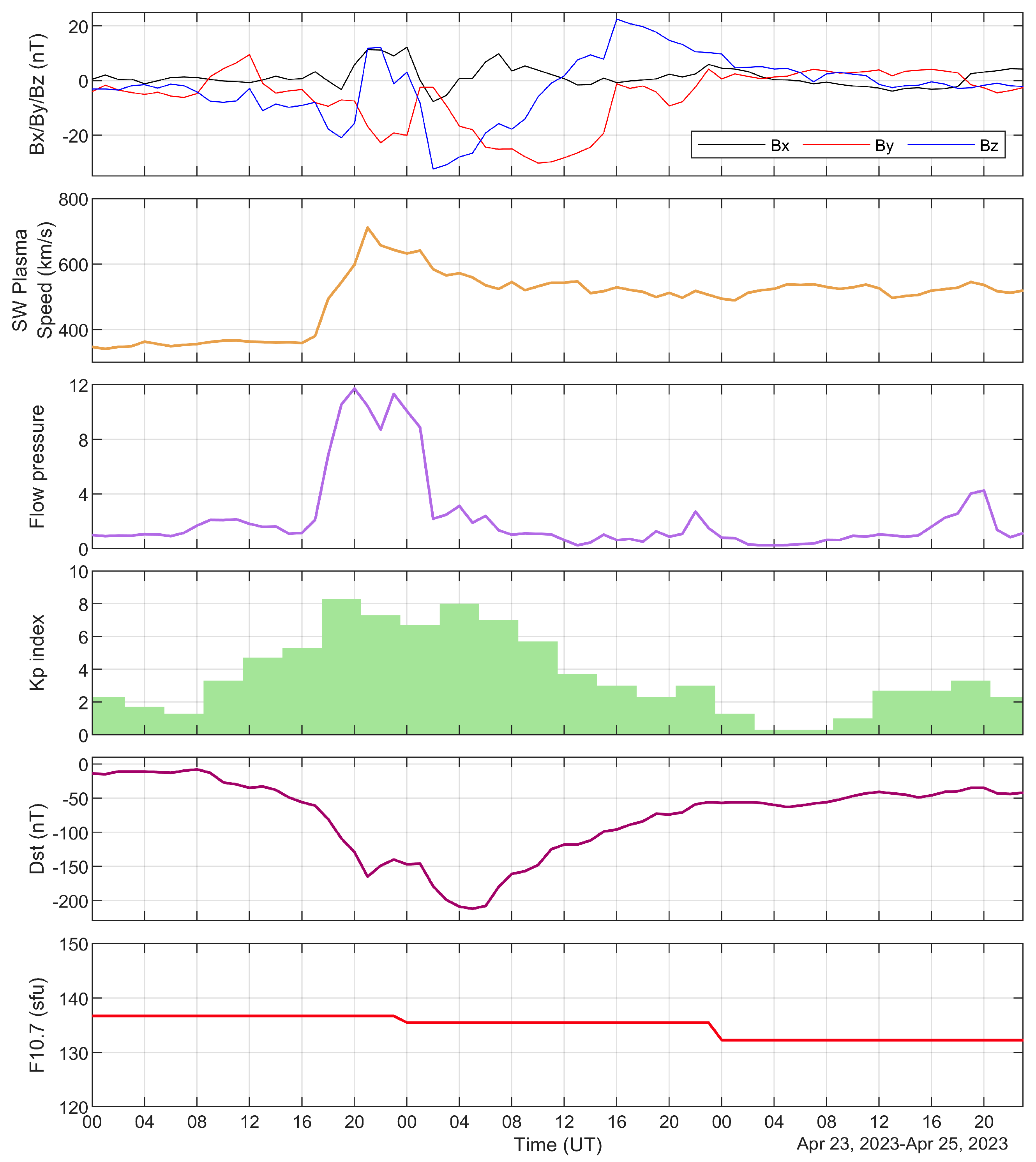
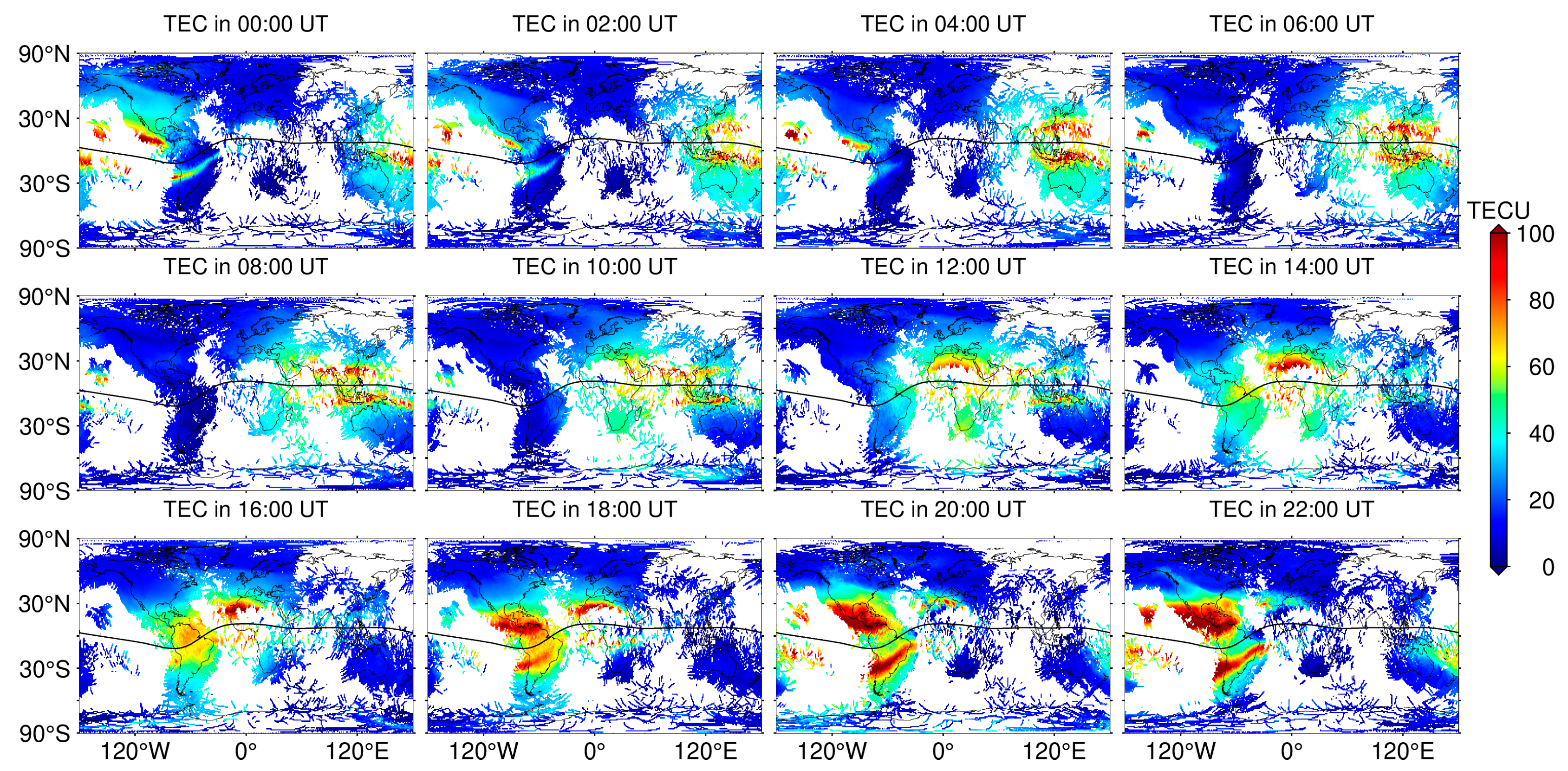

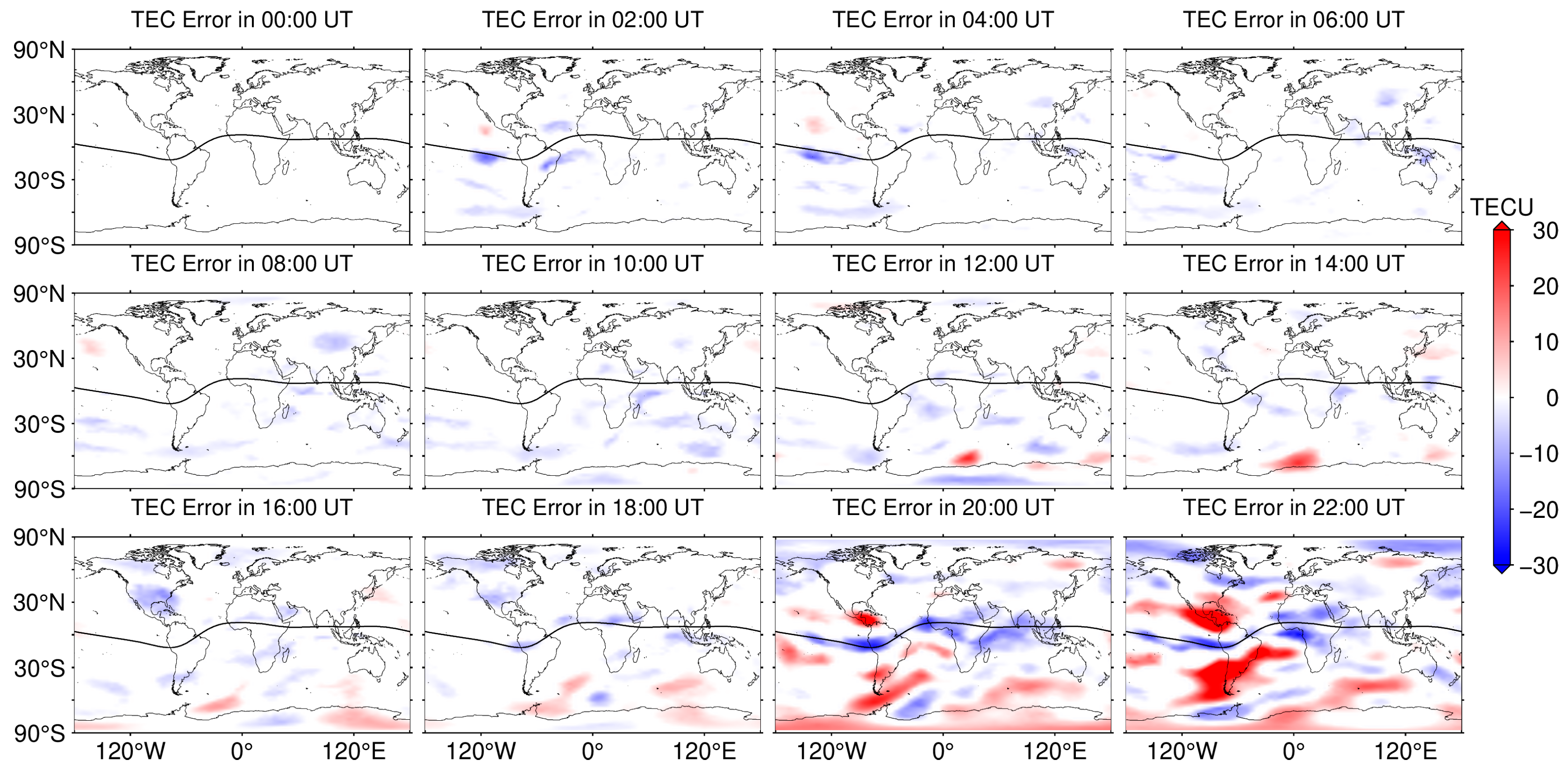

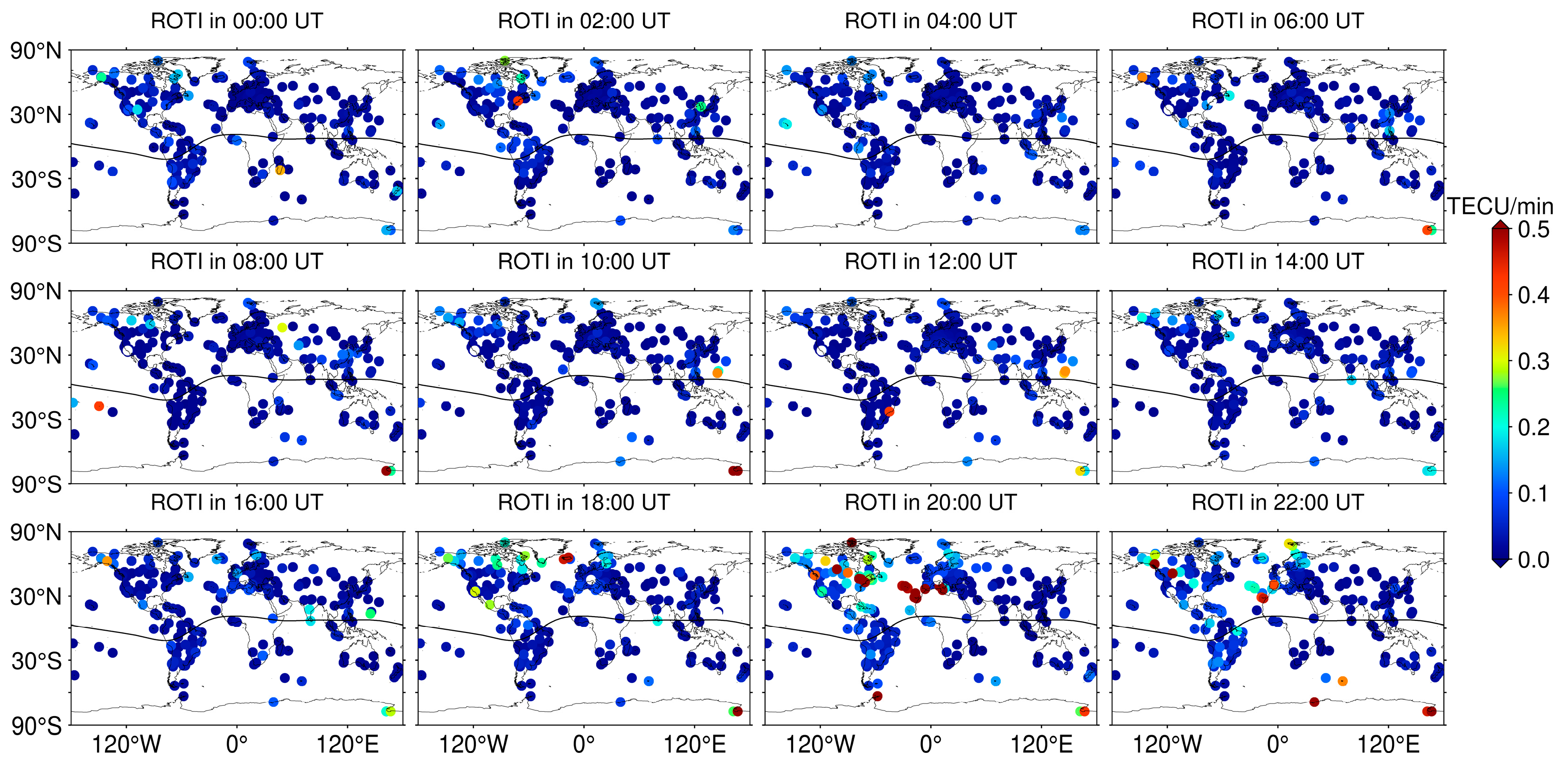

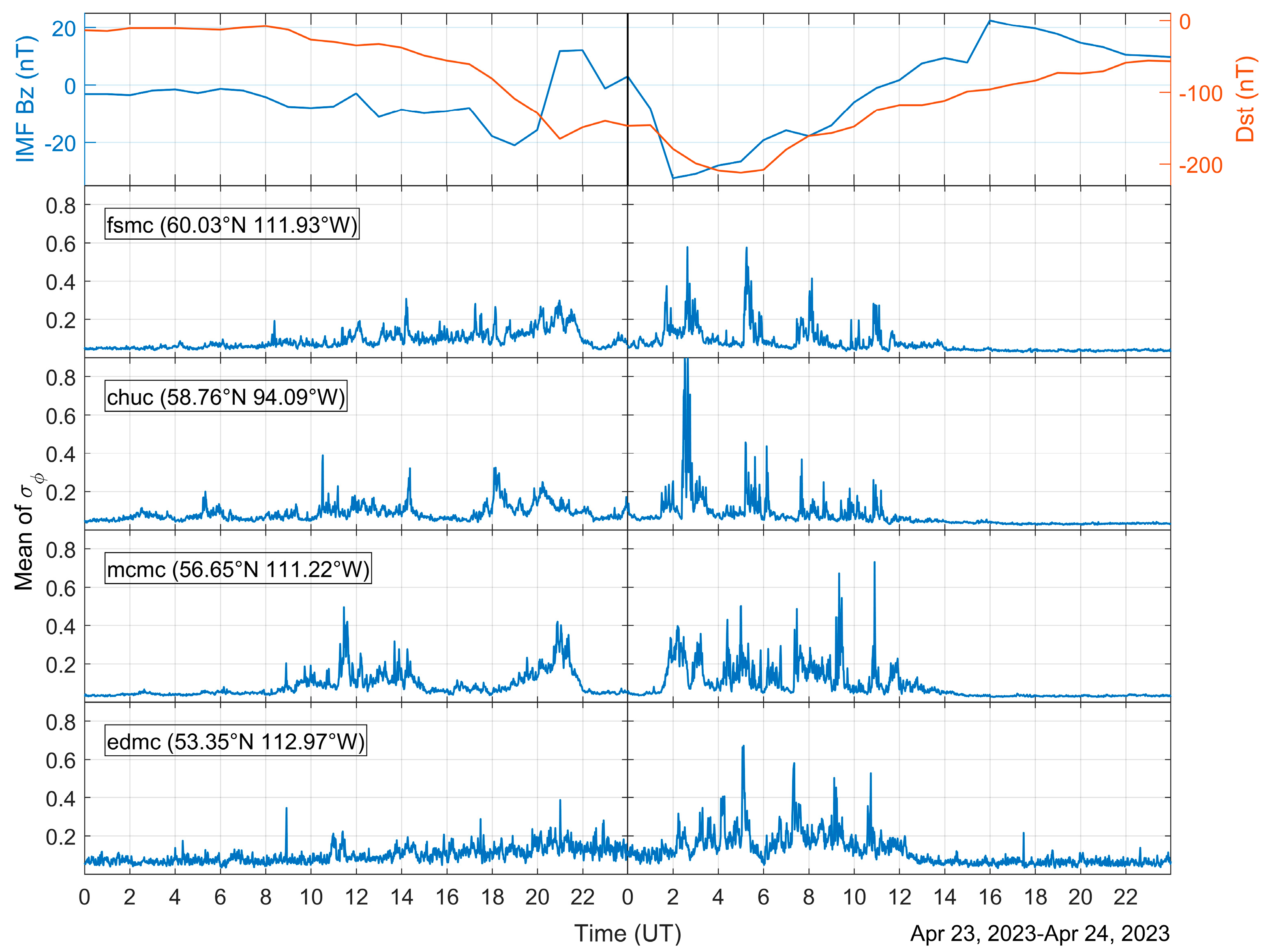
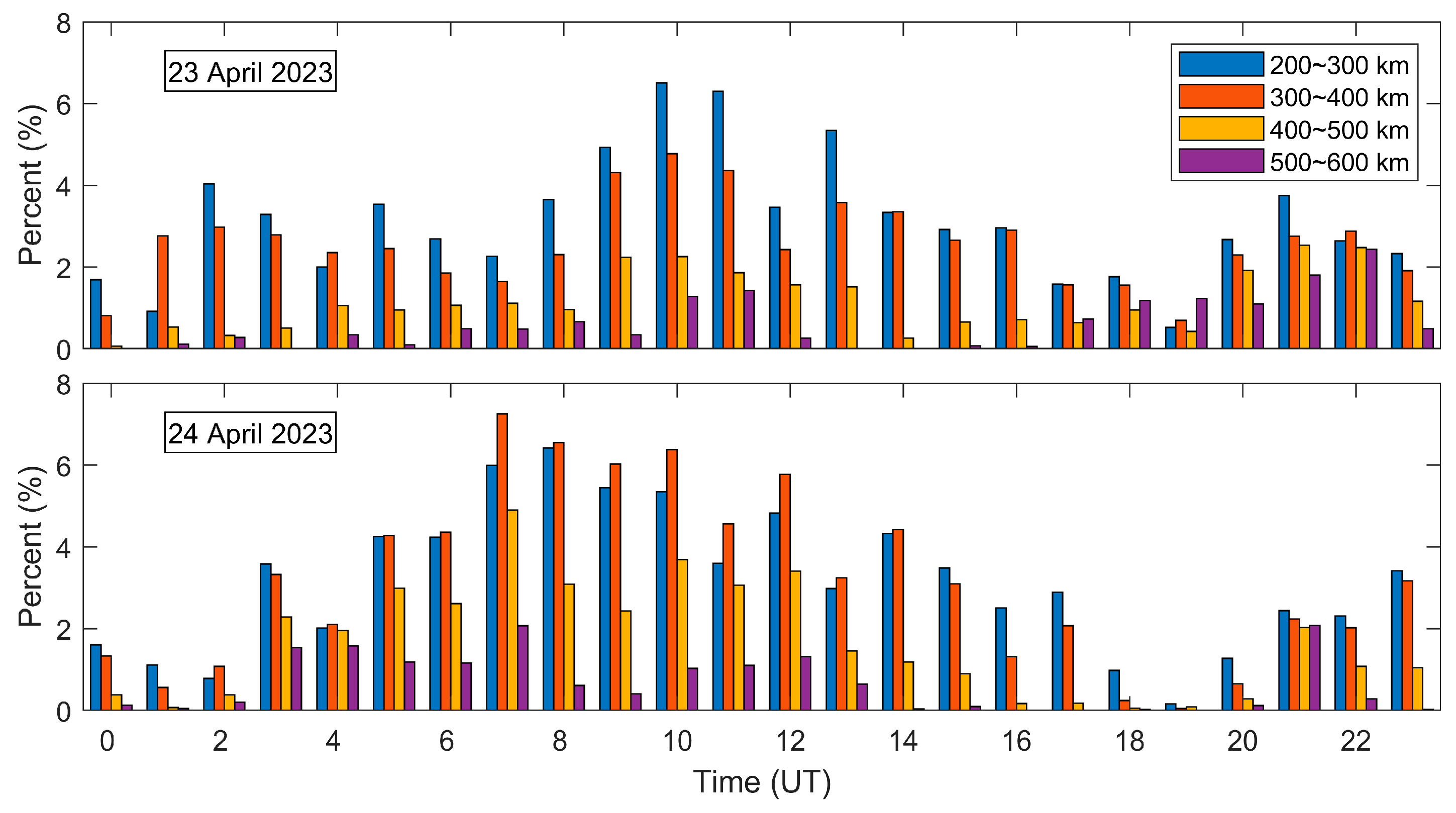
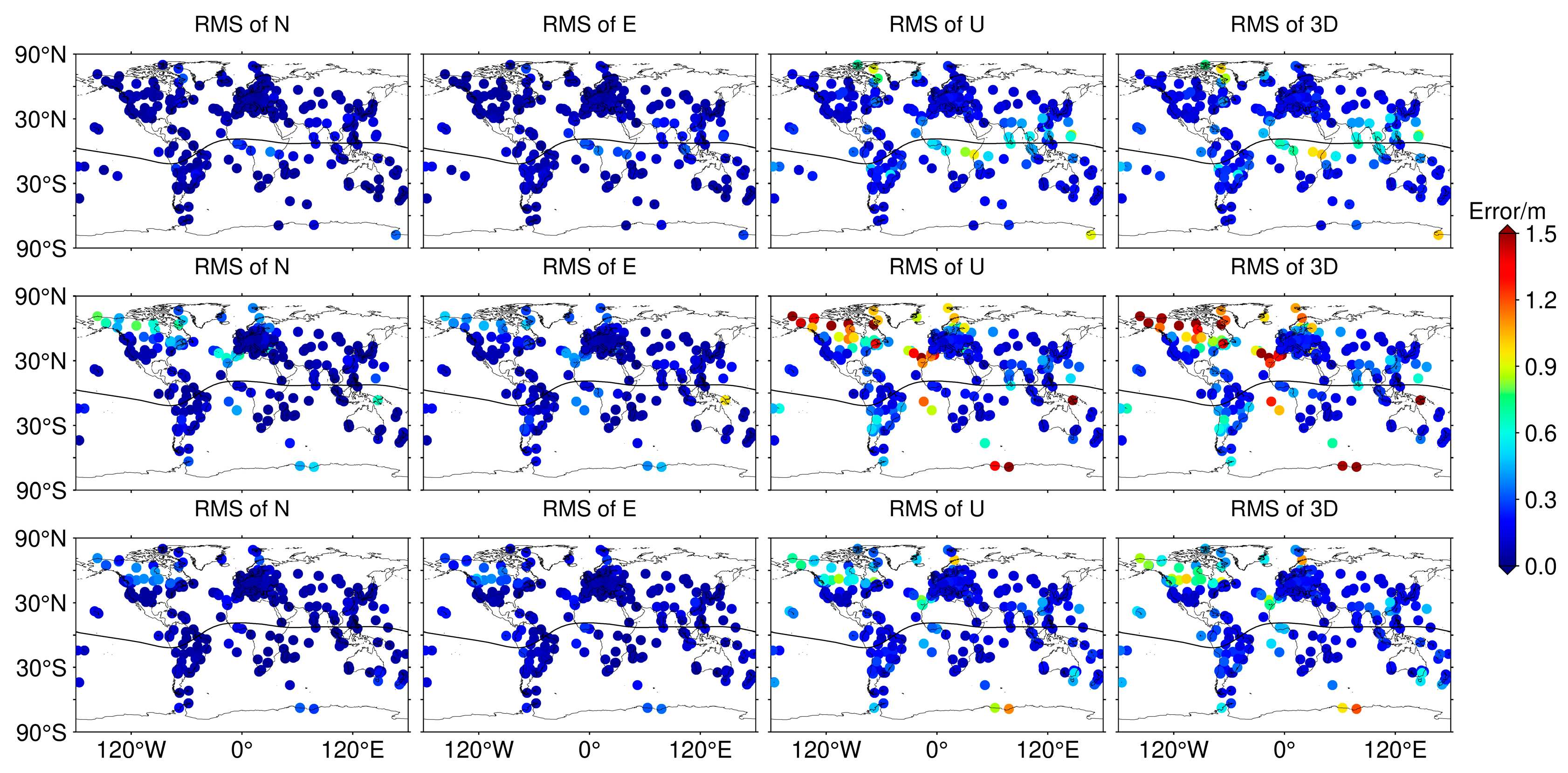
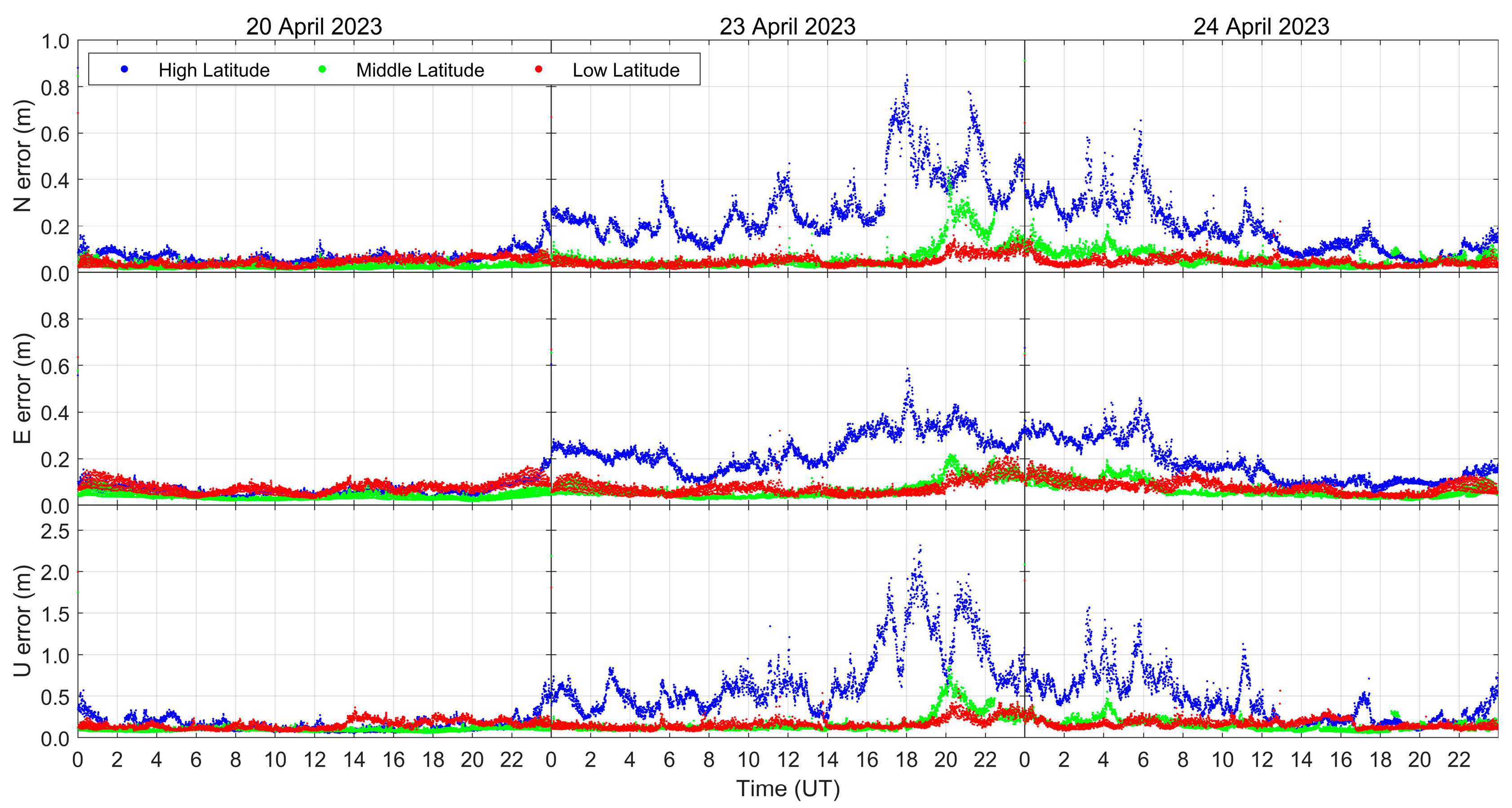
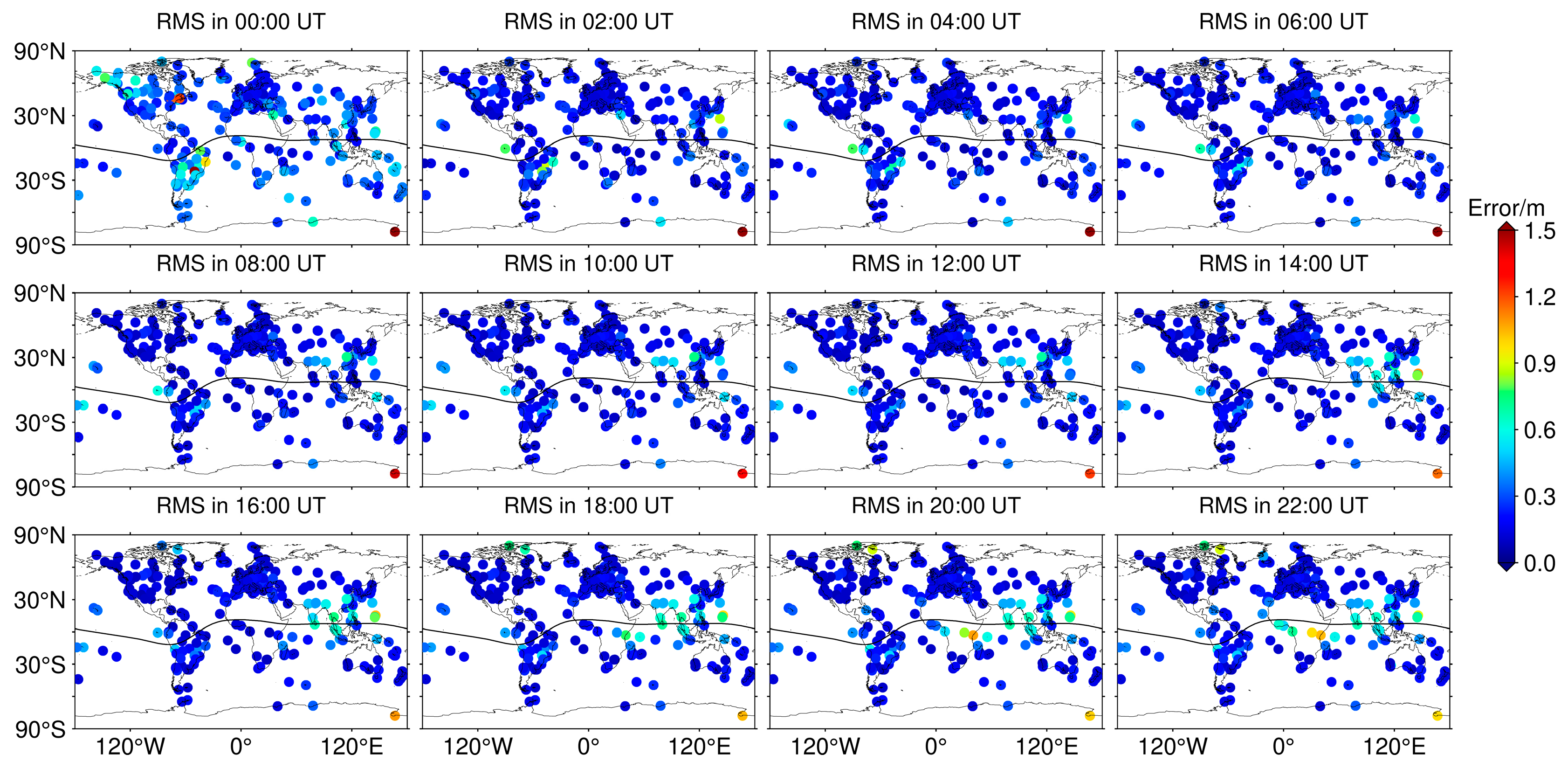
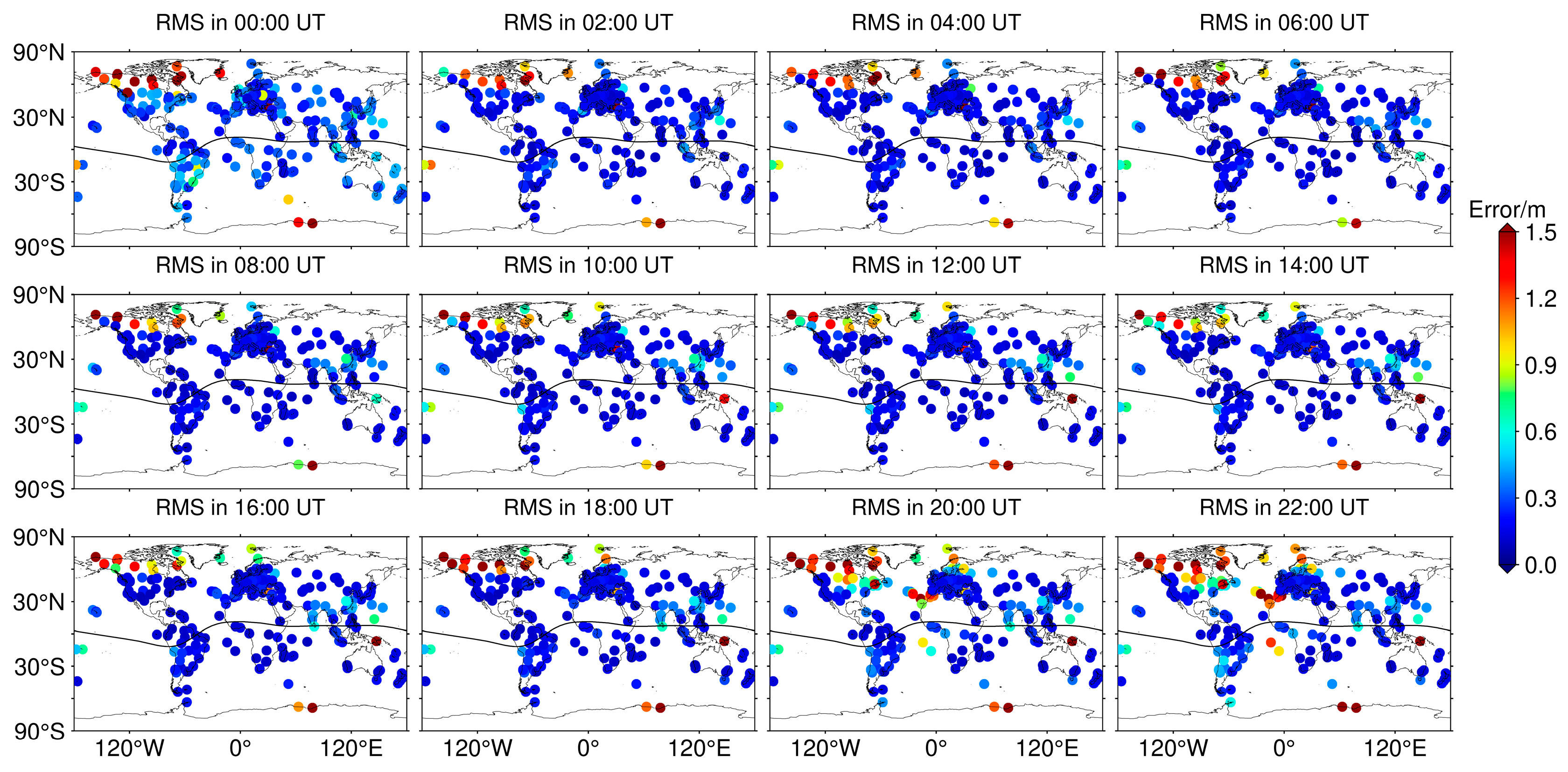
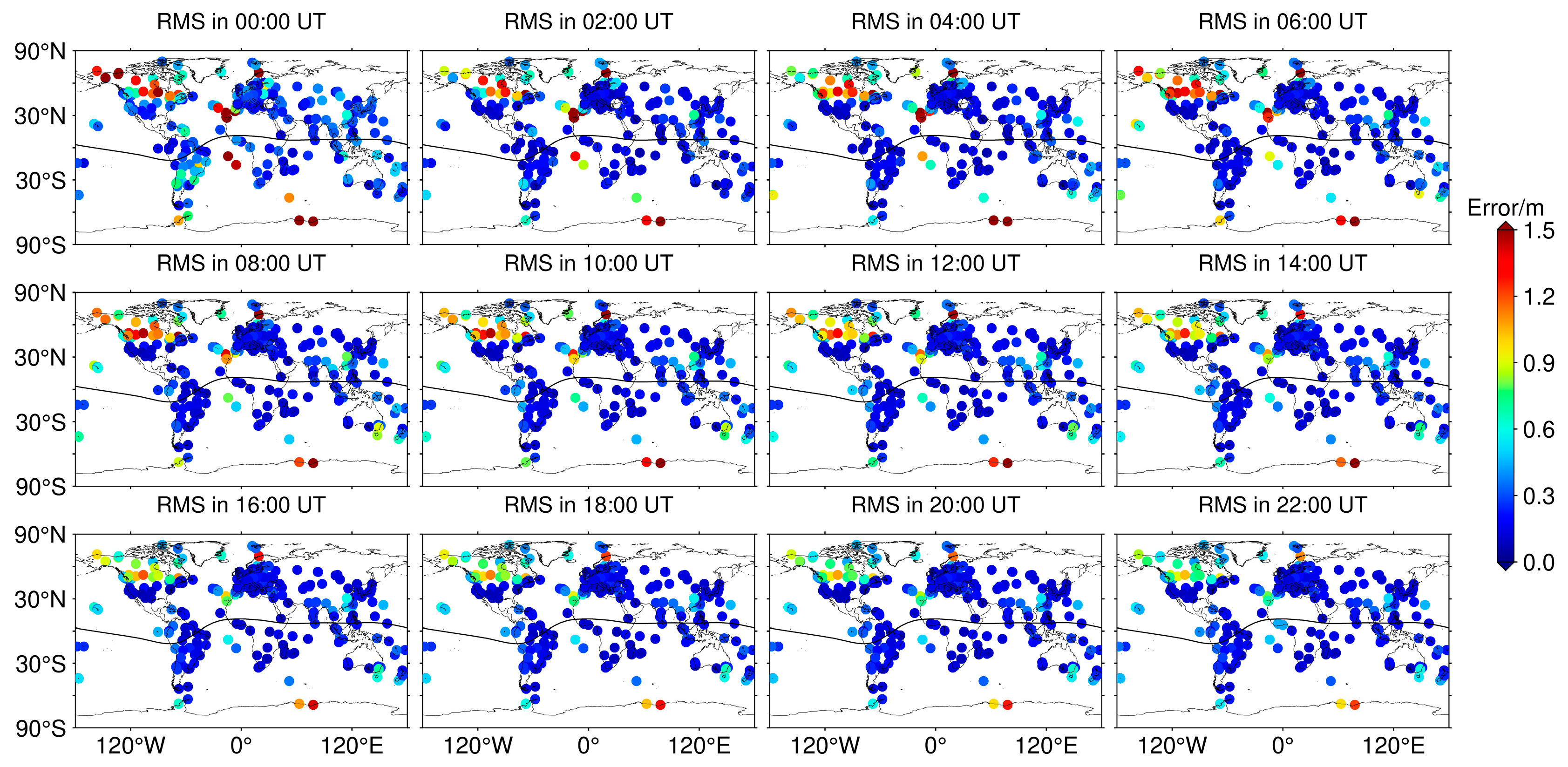
| Items | Strategy |
|---|---|
| Sampling interval | 30 s |
| Frequencies | GPS L1 and L2 |
| Filter type | Smoother combined solution with forward and backward filter solutions |
| Elevation mask angle | 15° |
| Satellite orbit and clock | CODE precise ephemeris and precise clock files |
| Earth tides | Solid earth tides, ocean tide loading, and pole tide corrections |
| Ionospheric delay | Ionosphere-free linear combination with dual-frequency measurements is used for ionospheric correction |
| Tropospheric delay | Estimate ZTD + grad |
| Receiver reference coordinates | IGS SINEX files |
| Satellite antenna phase center correction | IGS20.atx |
| Differential code bias | CODE products (P1C1, P1P2, P2C2 files) |
Disclaimer/Publisher’s Note: The statements, opinions and data contained in all publications are solely those of the individual author(s) and contributor(s) and not of MDPI and/or the editor(s). MDPI and/or the editor(s) disclaim responsibility for any injury to people or property resulting from any ideas, methods, instructions or products referred to in the content. |
© 2023 by the authors. Licensee MDPI, Basel, Switzerland. This article is an open access article distributed under the terms and conditions of the Creative Commons Attribution (CC BY) license (https://creativecommons.org/licenses/by/4.0/).
Share and Cite
Wang, Y.; Yuan, Y.; Li, M.; Zhang, T.; Geng, H.; Wang, G.; Wen, G. Effects of Strong Geomagnetic Storms on the Ionosphere and Degradation of Precise Point Positioning Accuracy during the 25th Solar Cycle Rising Phase: A Case Study. Remote Sens. 2023, 15, 5512. https://doi.org/10.3390/rs15235512
Wang Y, Yuan Y, Li M, Zhang T, Geng H, Wang G, Wen G. Effects of Strong Geomagnetic Storms on the Ionosphere and Degradation of Precise Point Positioning Accuracy during the 25th Solar Cycle Rising Phase: A Case Study. Remote Sensing. 2023; 15(23):5512. https://doi.org/10.3390/rs15235512
Chicago/Turabian StyleWang, Yifan, Yunbin Yuan, Min Li, Ting Zhang, Hao Geng, Guofang Wang, and Gang Wen. 2023. "Effects of Strong Geomagnetic Storms on the Ionosphere and Degradation of Precise Point Positioning Accuracy during the 25th Solar Cycle Rising Phase: A Case Study" Remote Sensing 15, no. 23: 5512. https://doi.org/10.3390/rs15235512
APA StyleWang, Y., Yuan, Y., Li, M., Zhang, T., Geng, H., Wang, G., & Wen, G. (2023). Effects of Strong Geomagnetic Storms on the Ionosphere and Degradation of Precise Point Positioning Accuracy during the 25th Solar Cycle Rising Phase: A Case Study. Remote Sensing, 15(23), 5512. https://doi.org/10.3390/rs15235512







